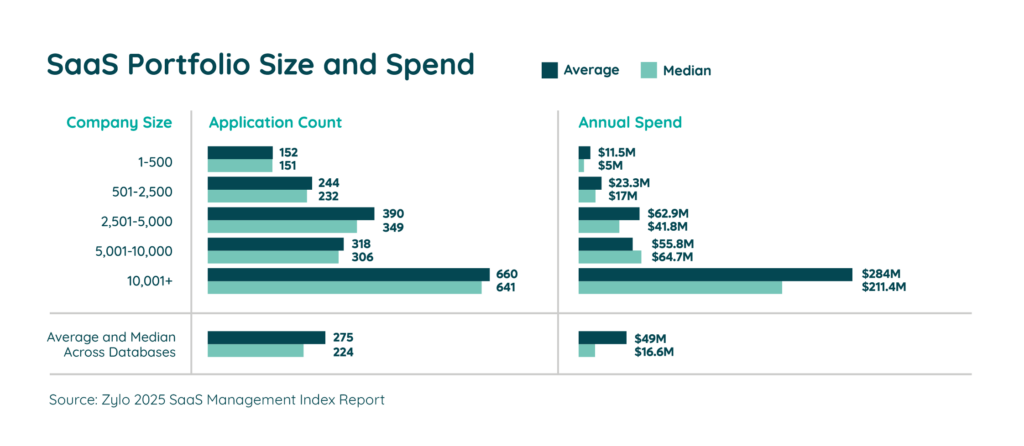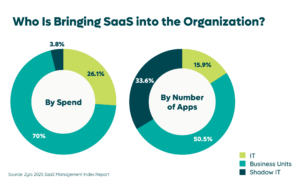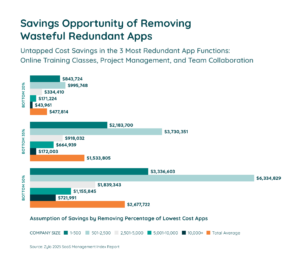Table of Contents
Software as a Service (SaaS) has forever changed business operations. Now, each employee can buy their own SaaS tools from the privacy of their own cubicle. But the reality is, another similar tool already existed. Or, the employee isn’t the only purchaser of the application.
The result? Software redundancy.
Now, the company not only has multiple tools that do the same thing, but multiple versions of the same SaaS app. Unfortunately, that does mean it’s serious.
“SaaS sprawl” is the extensive spread of software solutions across organizations. You probably have it, whether you know it or not. Enterprises use an average of 275 applications, which cost about $49M annually. Among these are redundant SaaS applications with overlapping features, which contribute to decreased productivity, increased costs, and inefficiency.

Zylo’s research indicates redundancy is common in SaaS. This is often due to decentralized software purchasing without central IT control, leading to unawareness of existing software.
Redundant SaaS applications cause unnecessary expense and operational issues. Organizations must manage their SaaS portfolios and eliminate redundancies to improve efficiency and save money. Otherwise, you may find yourself saying, “Oops, I bought it again.” Let’s explore strategies for removing redundant applications from your SaaS ecosystem.
Software Redundancy Is More Pervasive Than You Think
Software redundancy permeates organizational tech stacks to their detriment. Zylo’s data sheds light on the top five most redundant functions plaguing businesses today:
- Online Training Classes: With an average of 14 applications per organization, the abundance of online training tools reflects the need to control the available options.
- Project Management: Averaging 10 applications, the redundancy in project management tools increases the challenge of coordinating and streamlining project workflows.
- Team Collaboration: With an average of 10 applications, the redundancy in team collaboration tools often results in siloed information and redundant communication.
- Digital Assets: Organizations use an average of 9 digital asset management applications, highlighting the need for more efficient multimedia content management.
- Governance, Risk & Compliance: With an average of 8 applications, redundant governance tools showcase the prioritization of risk mitigation in modern enterprises.
Contrary to the belief that IT departments control software purchases, they only manage 26% of the spending and 16% of applications. Departments and employees often purchase new tools without realizing similar applications already exist.

This leads to significant challenges in managing the SaaS portfolio. The issue isn’t just the high number of applications—it’s the overlap in tool usage within the organization. Decentralized software acquisition leads to duplication, hampering efforts to improve workflows.
The problem of software redundancy means that organizations need to address the underlying issues and develop strategies to streamline their SaaS portfolios. Centralized software procurement and eliminating redundant applications can reduce bloat, conserve resources, and improve operational efficiency.
Why Software Redundancy Is Critical to Eliminate
Software redundancy is a significant challenge for organizations. That’s why you need to take strategic action to mitigate its business impacts.
Software Bloat
Your employees might think that app was sent from above, but it’s not that innocent. On average, organizations manage 275 applications and collectively spend $49M annually on SaaS subscriptions. This expense hinders the management and scalability of the SaaS portfolio.
Unnecessary Spending
Duplicate SaaS applications equals wasted spend. Organizations often overlook existing tools with similar features, resulting in the misuse of funds that could be better allocated to other projects or capability enhancement.
If you consider the top 3 most redundant functions—online training classes, project management, and team collaboration—there’s significant savings opportunity. Our data shows there’s an average of $477K to $2.8M in potential cost savings just in those categories. When you eliminate this redundancy, it enables you to reallocate resources across the business.

Operational Inefficiencies
Redundant tools acquired without IT department oversight compound into wasted time and effort. Departments and employees may acquire new applications without considering system integration or company workflows, creating data silos and communication barriers that impede productivity. Centralizing procurement and streamlining your SaaS inventory can address these inefficiencies and improve efficiency.
CISO Steve Gentry shared on SaaSMe Unfiltered, “It’s not just, ‘Let’s compare applications. Let’s compare people across all the redundant applications.’ We’ve got this many users who are in all nine of those applications. This cannot be good or efficient for them.”
Proactively consolidating the SaaS portfolio can lead to significant benefits, drive innovation, and ensure long-term success in the digital landscape.
Evolving Your SaaS Governance Framework for the Digital Workplace
Learn MoreSteps to Remove Software Redundancy from Your Stack
Addressing software redundancy with precision requires a structured approach that includes careful analysis, engaging stakeholders, reviewing usage data, and standardizing your toolset. The following guidelines will help you refine your organization’s SaaS offerings, maximize resource efficiency, and bolster operational effectiveness.
- Don’t Get Lost in the SaaS Chaos: Develop an exhaustive inventory of your company’s SaaS applications. Catalog and organize these applications, paying particular attention to the number within each functional group. Prioritize areas drawing the most financial resources or those fundamental to your enterprise’s workflow. This initial phase illuminates the extent of the overlap and paves the way for informed decision-making.
- Get Feedback from Users: Extract valuable feedback by connecting with the applications’ end users. Implement surveys to capture their sentiments and more profound reasoning behind the choice and frequency of tool usage. Work in tandem with various departments to identify unique requirements and processes that guide the selection and assimilation of these digital tools.
- Understand the Business Value of Each App: Examine usage data and financial outlays to determine each SaaS tool’s actual value and financial sensibility. Assess the level of engagement with each application and pinpoint instances where users are redundantly deploying multiple tools for overlapping tasks. This evaluation uncovers each software’s tangible benefits and unveils avenues for cost-effective optimization.
- Determine the Amount of Redundancy You’re Okay With: Acknowledge that some level of redundancy might be warranted, reflecting your organization’s unique requirements and preferences. Identify the essential number of applications needed to meet business objectives while curbing unnecessary overlaps. This consideration is the cornerstone for consolidating the software stack and ensuring uniformity within the organization.
- Rationalize Apps That Don’t Fit the Bill: Armed with the insights from your evaluations, rationalize your SaaS lineup by discarding superfluous apps. Eliminate software that fails to meet core business objectives, incurs high costs, suffers from low engagement, or replicates features better served by other options. Pay particular attention to subscription renewal timelines to phase out redundant tools during these windows.
- Prevent an “Oops, I Did it Again” Moment: Prevent future redundancies by endorsing a uniform set of software solutions for your company. Formulate explicit guidelines for software acquisition and offer employees a comprehensive view of available applications. Simplify the process for requesting new software, so employees can access the tools they need while still following your established standards.
“Figure out what your business objectives are, and use that data to assist you and really commit to using a system. By doing that, we’ve been able to understand our portfolio. We know what we have right now. We know where we’re duplicative.”
– Chris Asing, Head of Business Technology at Redis
By implementing these strategies and taking steps to reduce redundancy, organizations can fine-tune their SaaS portfolios, diminish expenditures, and elevate their operational efficiency. Unifying the software selection process cultivates a culture of consistency and cooperation, establishing a solid foundation for a well-managed SaaS stack.
Just So Typically SaaS
Wishing that SaaS heroes truly existed? Implement the right governance to contain SaaS sprawl and redundant apps. Doing so will help you reduce software costs and increase efficiency across any organization. Determine the right approach with our ebook, Evolving Your SaaS Governance Framework for the Digital Workplace.


 –
–